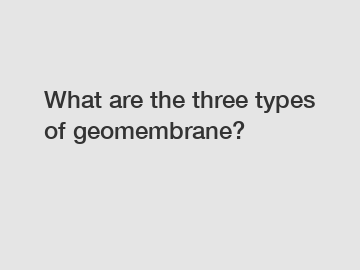What are the three types of geomembrane?
What are the three types of geomembrane?
Geomembranes play a crucial role in numerous industries, providing an impermeable barrier for containment applications. But what exactly are the three types of geomembrane? In this article, we will explore high-density polyethylene (HDPE), low-density polyethylene (LDPE), and polyvinyl chloride (PVC) geomembranes, their unique characteristics, and their applications.
1. High-Density Polyethylene (HDPE) Geomembrane.

HDPE geomembranes are widely used and known for their exceptional durability and resistance to chemicals, UV radiation, punctures, and temperature variations. These geomembranes are manufactured through the process of extrusion, which involves melting HDPE resin and shaping it into a continuous sheet. HDPE geomembranes are available in various thicknesses, ranging from 0.5mm to 3mm, making them suitable for a wide range of applications.
HDPE geomembranes find extensive usage in industries such as waste management, mining, and agriculture. Due to their high chemical resistance, they are ideal for landfill liners, preventing the leaching of contaminants into the soil and groundwater. In mining applications, HDPE geomembranes act as barriers to prevent acid mine drainage and protect the environment. Additionally, they are also employed in agriculture for lining channels, reservoirs, and canals to prevent water loss through seepage.
2. Low-Density Polyethylene (LDPE) Geomembrane.
LDPE geomembranes, also known as flexible geomembranes, possess excellent flexibility, elongation properties, and resistance to environmental stress cracking. Produced through the process of co-extrusion, LDPE geomembranes consist of multiple layers of LDPE resins, with each layer serving a specific purpose. These geomembranes offer a high degree of impermeability and are particularly suitable for applications where deformation and settlement are expected.
One prominent application of LDPE geomembranes is in the construction of reservoirs, ponds, and canals. Due to their flexibility, they can easily adjust to settlement or ground movement, ensuring the integrity of the water containment system. LDPE geomembranes are also utilized in secondary containment systems for storage tanks, offering a reliable barrier against potential leaks or spills.
3. Polyvinyl Chloride (PVC) Geomembrane.
PVC geomembranes are renowned for their excellent chemical resistance, making them a preferred choice for applications involving exposure to aggressive chemicals and gases. These geomembranes are manufactured using the process of calendaring, which involves pressing PVC resin between heavy rollers to create a continuous sheet. PVC geomembranes are available in various thicknesses, ranging from 0.5mm to 3mm, catering to the specific needs of different projects.
One of the primary applications of PVC geomembranes is in the lining of primary and secondary containment systems for industrial plants, where chemical resistance is of utmost importance. Additionally, PVC geomembranes are commonly used in the agriculture sector to line irrigation canals, wastewater treatment plants, and aquaculture ponds, preventing seepage and maintaining water quality.
In conclusion, the three types of geomembranes - HDPE, LDPE, and PVC - each possess unique properties that make them suitable for a variety of applications. HDPE geomembranes excel in chemical resistance and durability, LDPE geomembranes offer flexibility and resistance to deformation, and PVC geomembranes provide excellent chemical resistance. This range of geomembranes allows industries to select the most appropriate type based on their specific requirements, ensuring effective containment and protection of the environment. So, next time you encounter geomembranes, remember these three types and their valuable contributions across various sectors.
If you are looking for more details, kindly visit geocomposite exporter, geogrid mesh price, geogrid mesh.
142
0
0


Comments
All Comments (0)